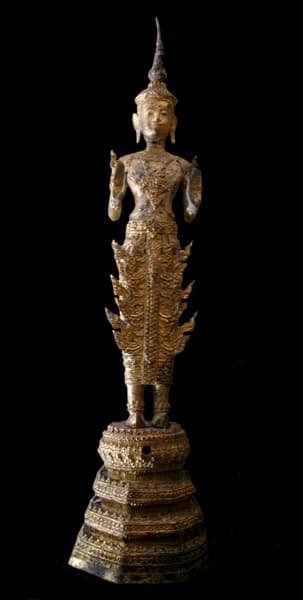Rattanakosin Gilt Bronze Sculpture of the Walking Buddha, 18th Century CE - 19th Century CE
Gilt Bronze
8 x 34.25
X.0258
After the destruction of Ayutthaya in 1767 by the Burmese, King Tak Sin the Great drove out the invaders and reunified the country, establishing a new capital at Thonburi, a...
After the destruction of Ayutthaya in 1767 by the Burmese, King Tak Sin the Great drove out the invaders and reunified the country, establishing a new capital at Thonburi, a strategic river port town at the mouth of the Chao Phraya River. After Tak Sin was deposed, Thong Duang was chosen as king, known as Rama I, establishing the Chakri Dynasty which continues to reign over Thailand to this day. He moved the capital across the banks of the Chao Phraya River to its present location of Bangkok. The art of this period is known as the Rattanakosin style, although it is also referred to as the Bangkok style. Naturally, Rattanakosin art carried on many of the traditions of the Ayutthayan style, thereby establishing a link with the past.
The historical figure, Buddha Gautama Sakyamuni is the Buddha of compassion who, having achieved the highest evolutionary perfection, turns suffering into happiness for all living beings. Born around 560 B.C. somewhere between the hills of south Nepal and the Rapti river, his father was a Raja who ruled over the northeastern province of India, the district including the holy Ganges River. The young prince was married to Yashoda when he was about 17 years old and together they had a son named Rahula. At the age of 29, he left his life of luxury, as he felt compelled to purify his body and make it an instrument of the mind by ridding himself of earthly impulses and temptations.
This type of standing Buddha is commonly referred to as the “walking Buddha.” Apparently, this posture appears to illustrate certain texts that were recorded during the Sukhothai period. Specifically, this form seems to relate to the Buddha as described in canons written during the reign of Ramkhamheng in the late 13th Century. In the city of Sukhothai, representations of the walking Buddha were found placed against the walls of temples. One hand is traditionally held in the Abhaya mudra, which symbolizes protection, benevolence, and peace, while the other arm hangs beside the body. Sometimes, one leg is portrayed advancing forwards of the other, contributing to the designation of these figures as walking. This gorgeous gilt bronze Buddha is represented standing, or perhaps “walking,” holding both his hands in the double Abhaya mudra. A stylized flame of enlightenment rises from the top of his ushnisa, a bump symbolic of the Buddha’s infinite wisdom that here resembles a stupa found in traditional Buddhist architecture. The Buddha wears a robe decorated in floral motifs, a type specific to the Rattanakosin era, from the reign of Rama III onward (1824 A.D.) Overall, this exquisite sculpture beautifully memorializes one of history greatest holy figures.
The historical figure, Buddha Gautama Sakyamuni is the Buddha of compassion who, having achieved the highest evolutionary perfection, turns suffering into happiness for all living beings. Born around 560 B.C. somewhere between the hills of south Nepal and the Rapti river, his father was a Raja who ruled over the northeastern province of India, the district including the holy Ganges River. The young prince was married to Yashoda when he was about 17 years old and together they had a son named Rahula. At the age of 29, he left his life of luxury, as he felt compelled to purify his body and make it an instrument of the mind by ridding himself of earthly impulses and temptations.
This type of standing Buddha is commonly referred to as the “walking Buddha.” Apparently, this posture appears to illustrate certain texts that were recorded during the Sukhothai period. Specifically, this form seems to relate to the Buddha as described in canons written during the reign of Ramkhamheng in the late 13th Century. In the city of Sukhothai, representations of the walking Buddha were found placed against the walls of temples. One hand is traditionally held in the Abhaya mudra, which symbolizes protection, benevolence, and peace, while the other arm hangs beside the body. Sometimes, one leg is portrayed advancing forwards of the other, contributing to the designation of these figures as walking. This gorgeous gilt bronze Buddha is represented standing, or perhaps “walking,” holding both his hands in the double Abhaya mudra. A stylized flame of enlightenment rises from the top of his ushnisa, a bump symbolic of the Buddha’s infinite wisdom that here resembles a stupa found in traditional Buddhist architecture. The Buddha wears a robe decorated in floral motifs, a type specific to the Rattanakosin era, from the reign of Rama III onward (1824 A.D.) Overall, this exquisite sculpture beautifully memorializes one of history greatest holy figures.



